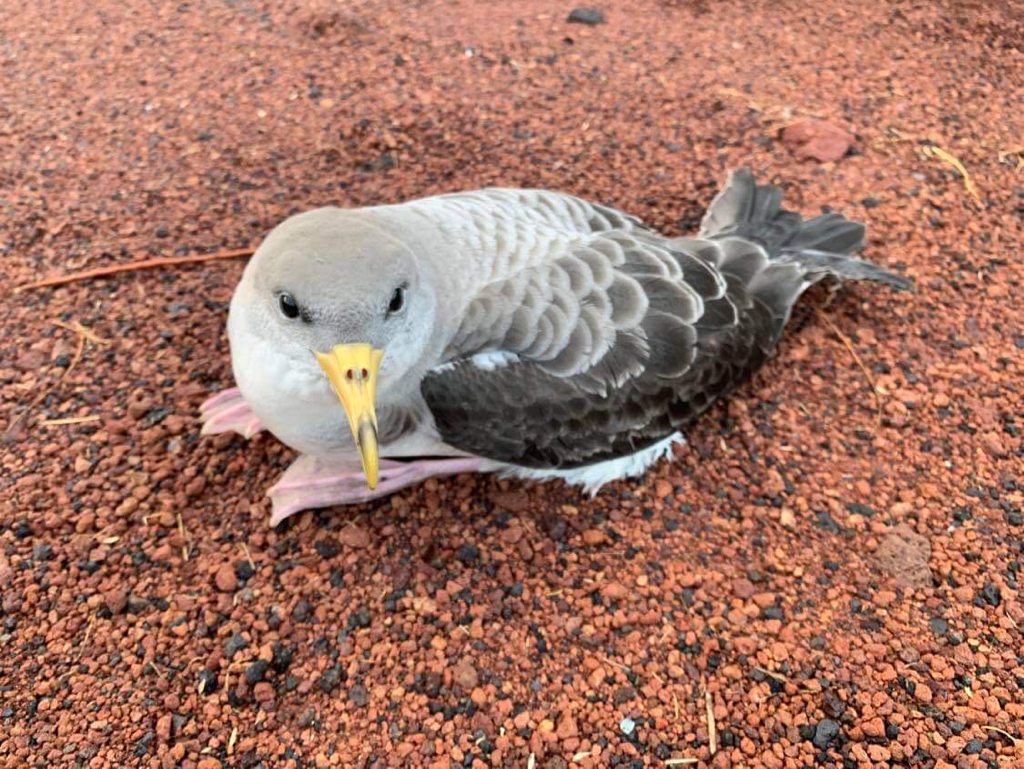|
Tuesday this week, October 25, we found a seabird laying on its back on the beach, unable to walk or fly. With research we learned it is a Cagarro, also called a Shearwater. A person wrote to us "These amazing birds (Shearwaters) are companions way out in the middle of the ocean." Each year at this time, young birds go out of their nests in the cliffs, and get stranded like this. We found another today, dead. But the bird yesterday was very much alive. I came back with gloves, towel and box and brought him home then made calls after learning there are rescue centers on the Azores for these endangered birds. By the end of the day, a man from the rescue center came, said the bird has no physical injuries but lost its equilibrium, and said it would be taken to a recovery station on Pico Island. What a marvelous service! The next day we found another Shearwater, and the following day two more! Four total this week were alive, and some more dead. One of the live ones was badly injured, the others seem okay besides loss of balance. I knew nothing about these birds before, but after the experience read, "The Cory’s shearwater life cycle – Tough life among waves! "Cory’s shearwaters are one of the most representative seabirds in the Azores. They reach adulthood at the age of 7 and for the next 30 years they travel every year to the Azores to breed. Here, they spend eight months, staying in offshore waters the rest of the time.... "...They are tough birds adapted to the ocean and able to survive the harsh conditions of winter storms. Excellent fliers, they use their long wings to glide on the surface without touching it. They can even dive down to 16m to catch their prey by using their wings to swim and, like other seabirds species, can drink the salty water by expelling the salt from a gland located in their nostrils.... "When they return to their colonies, in fact, they start calling each other’s with their peculiar calls. Their interesting sounds can be heard from March to October (in video can be heard few samples). [Gary - so that is the source of those amazing night calls!] "In the past fishermen passing by the shearwaters’ colonies thought they were haunted places. Their wailing calls were frightening people, who believed they were ghosts. "The Azorean population of Cory’s shearwaters represents at least 75% of the world population, which is a threatened species." "Description. This shearwater is identifiable by its size, at 45–56 cm (18–22 in) in length and with a 112–126 cm (44–50 in) wingspan. Species: C. borealis. Genus: Calonectris" https://youtu.be/7rOlGg9nEgI Photos are collected from this week... *** The night calls of the Cagarro are fascinating. I've actually laughed out loud, hearing them. On our morning walk to the beach today, Sunday October 30, we found two more live ones. These are the most lively yet. Now I feel more confident handling them. One was stuck under the rocks, so when I got to an open area, I let it go to see if it could fly. They need a long runway and at this time the beach is a boulder field. It ran but was unbalanced and by simply throwing a towel over it, it was subdued. The rescue center had left two Cagarro boxes with us, so perfect. They rest now in a dark storeroom until being picked up tomorrow. I asked about feeding or giving water, and the man said no, no. They must feed from the sea. I complimented the man on the government rescue service. He told me it was started years ago by the people, mainly school children. How wonderful that people care so.
0 Comments
Your comment will be posted after it is approved.
Leave a Reply. |
Archives
November 2023
|

 RSS Feed
RSS Feed
